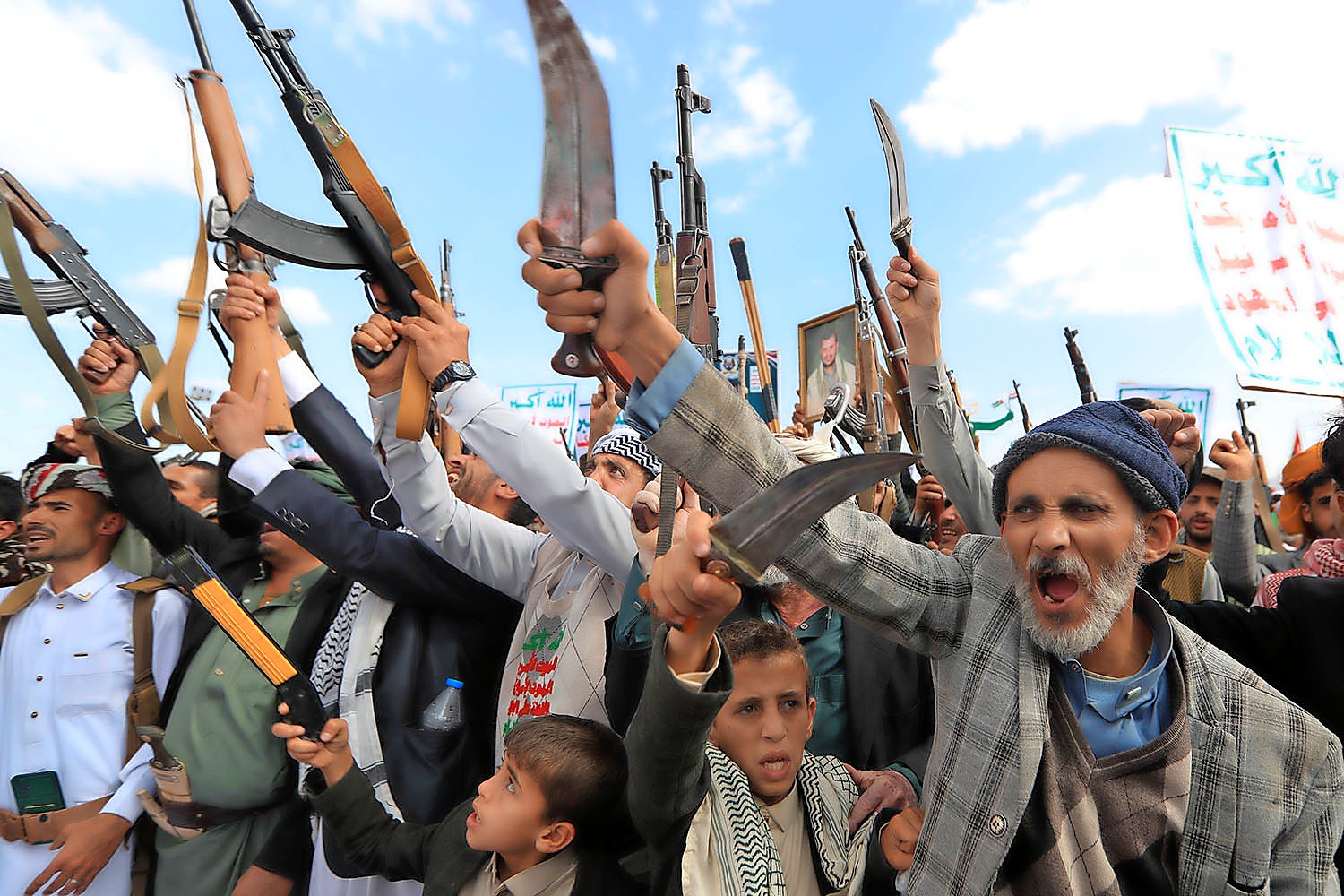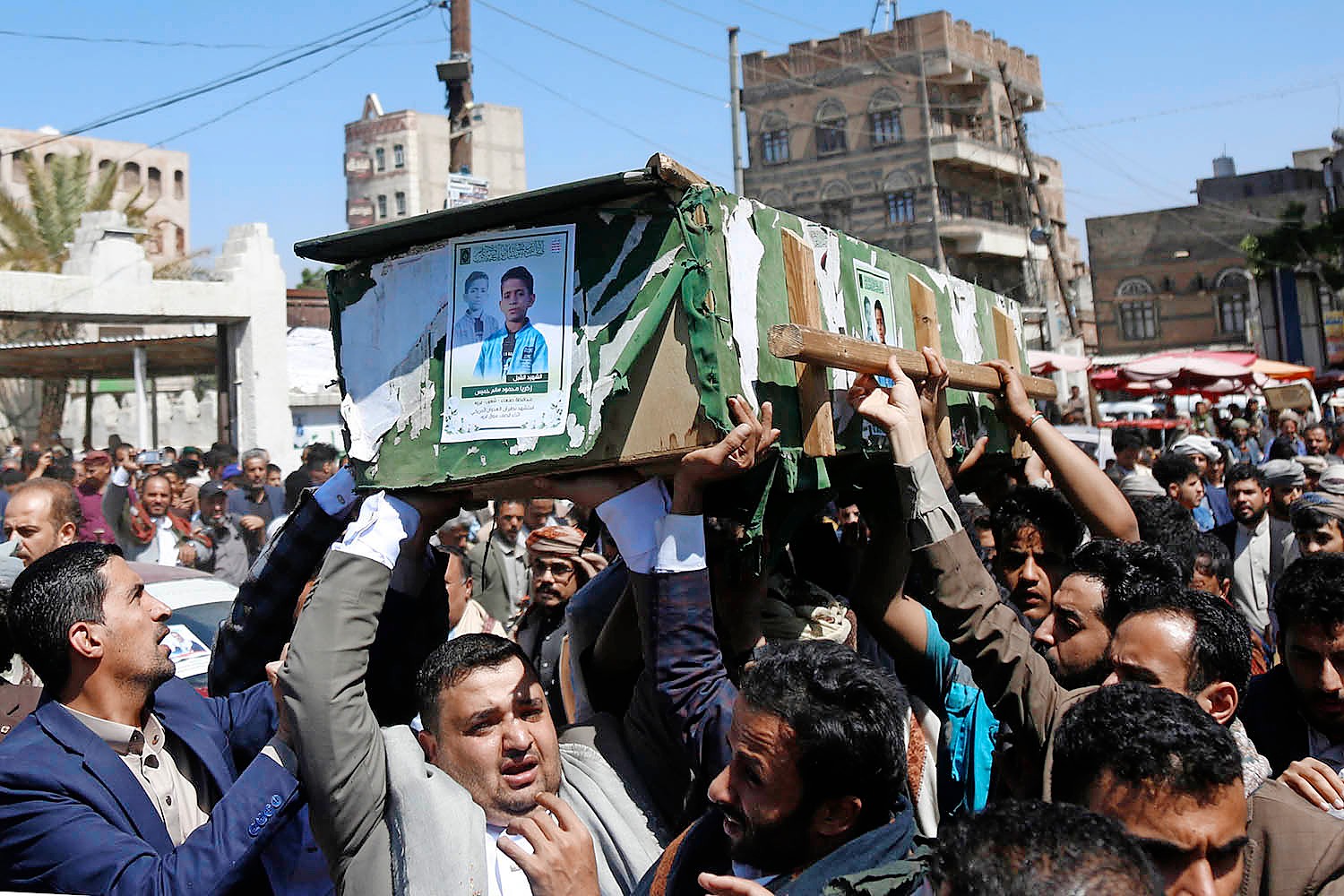Trapped on his side between two large slabs of concrete, a man stares into the camera. He murmurs something inaudible. The camera doesn’t dwell. Panning to the left in the semi-light of early dawn in northern Yemen, another survivor is trapped up to his waist. To the right, a lifeless body. A man face-down in the rubble with two corpses alongside. A head lifts. The man cries out. A dust-covered mattress is dragged out of the rubble to use as a makeshift stretcher. He’s pulled out, still face down.
At six minutes into the footage, the crater left by the US airstrike becomes visible. A contorted body is almost camouflaged amid the debris on the crater’s edge. By 24 minutes in, the count is at least 26 bodies caught on camera. The sun has risen over Sa’ada, a city that was devastated by some of the heaviest bombing on my last visit there during Saudi Arabia’s air war, and the flies are already starting to descend on the dead. The crowd of first responders and other Yemenis has grown to more than two dozen. At 33 minutes, bomb fragments are laid out for the camera.
The American airstrike on a migrant detention facility in Sa’ada, Yemen on 28 April was the 278th since US president Donald Trump launched a new bombing campaign against Yemen’s Houthis, the Iran-backed group that controls the most densely populated part of the country, on 15 March. At least 68 civilians, mostly African migrants, were reportedly killed and a further 47 injured, bringing the toll of civilian deaths in US strikes on Yemen to 237 since mid-March , according to figures collected by the conflict monitor Yemen Data Project. In a statement marking the first 100 days of Trump’s presidency, the US Department of Defense claimed last week that strikes had hit a thousand Houthi targets.
Less than 36 hours after the deadly strike, on Tuesday night, British Typhoon fighter jets joined the bombing campaign, carrying out airstrikes south of the capital, Sana’a, that defence secretary John Healey told parliament had targeted a drone manufacturing site.
British involvement goes even further. Analysis by The Observer of publicly available flight tracking data reveals that the RAF has been facilitating Trump’s bombing campaign from the start. RAF KC2 Voyagers have carried out at least 25 flights to provide air-to-air refuelling for the USS Harry S Truman and its strike carrier group, which is launching nightly bombing runs into Yemen from the Red Sea. That includes the night of the strike on the detained migrants.
Foreign secretary David Lammy noted in parliament the role of RAF refuelling in the initial US bombings, but there has been no further mention by the government of the five flights a week by aerial refuelling tankers from the British airbase in Akrotiri, Cyprus to the northern Red Sea.
The west’s war against the Houthis began in January 2024 in response to the Houthi targeting of commercial vessels in the Red Sea and Gulf of Aden. They had hijacked a cargo ship and its crew in a highly publicised operation in November 2023 that marked the beginning of a year of targeting Israeli-linked vessels and ships docking in Israeli ports in a declared response to Israel’s war on Hamas. Despite the US/UK bombing campaign, over the next 12 months the Houthis carried out almost 100 attacks against merchant vessels, sinking two and killing three merchant mariners.
The US/UK campaign ended in January 2025 with the Gaza ceasefire that led to a de-facto ceasefire in Yemen and the Red Sea, days before Joe Biden left office. Two months later, the Houthis gave an ultimatum to Israel to lift its blockade on Gaza or it would resume attacks. Preemptively, Trump launched his own version, describing Biden’s operation as “pathetically weak”.
The change in tactics raises questions for Keir Starmer’s government
The data on the two American operations reflects the contrast. Under Biden, a total of 307 strikes over 53 weeks resulted in 85 civilian casualties. In the first seven weeks of the new campaign, Trump’s air war has killed and injured 649 civilians and he has vowed to “completely annihilate” the Houthis.
Dr Ioannis Kalpouzos, a visiting professor at Harvard Law School and a specialist in the law of war, said the Trump-ordered airstrikes in Yemen appear to take a much looser approach to both precautions and target verification along with reduced transparency on strikes, shifting away from previous comparative restraint. The change in tactics pose a question for Keir Starmer’s government, which has signed on to a far more deadly campaign without a vote in parliament. There is also a question for the US and UK on the legal justification for the attacks against the Houthis.
The aim of the western airstrikes was to protect shipping routes through the Bab el-Mandeb, the maritime choke point between Yemen and the Horn of Africa which 10% of global trade passes through. Traffic through the Red Sea is consistently down by around 50% as commercial shipping companies reroute to the longer and more costly journey around the Cape of Good Hope. Lost Suez Canal revenue cost Egypt more than $7bn in 2024.
But Kalpouzos said the argument does not fit comfortably with the law. “The underlying rationale of protecting international trade and commerce is not a justification under international law for the use of force,” he said.

What’s more troubling, say legal experts, is that Houthi attacks in the Red Sea had stopped months before Trump launched the new bombing campaign. The last successful Houthi attack on a commercial vessel, reported by the US-UK armed forces Joint Maritime Information Center (JMIC), was in October 2024. The last attempted attack was against an Israeli ship, the Anadolu S, on 18 November.
Regardless, both the US and UK continue to argue that the Houthi threat to shipping lanes justifies the bombing campaign. Defense secretary Pete Hegseth said in a Fox News interview: “The minute the Houthis say we’ll stop shooting at your ships, we’ll stop shooting at your drones. This campaign will end, but until then it will be unrelenting.” The British government explanation last week was more reticent, but still justified strikes as a response to Houthi attacks on international shipping.
The air campaign British fighter jets joined on Tuesday is markedly different from the one launched jointly by the UK and US in January last year. If there is a similarity, it is with the seven-year Saudi Arabian air war, which the Labour party – Starmer included – opposed. Indeed, in 2022, the Saudi-led coalition hit the same migrant detention facility bombed by the US on Monday, killing 91 people.
Iona Craig is a freelance journalist who has reported on Yemen for the past 15 years and also works with the independent Yemen Data Project.
